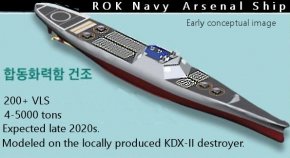Arsenal ships would require escort, for sure. They could be embedded in CSGs, or just operate within the influence area of a CSG or land base. Assuming Guam was hardened to survive missile strikes, arsenal ships could operate under its fighter and AEW air cover.I would argue that yes, it would be worse, because the arsenal ship would be essentially unable to defend itself (unless it was fitted with the appropriate systems like are found aboard a DDG) and would likely not even be aware that it was being targeted or engaged until it was too late. If the USN to operate a 500-cell arsenal ship within striking range of mainland China, the PRC would become aware of that fact. I would then expect them to make finding it a priority, and following that, finding a way to neutralize it before the missiles in the VLS cells could be launched. In order to prevent that, the USN would need to embed arsenal ships into CSG's to protect them vs. aerial, surface and undersea threats. I frankly think the cost too high, and potential strike value too little for it to really be considered worthwhile.
If the USN really did wish to increase it's potential strike capability and add a conventional strike deterrent, then I believe that modifying some of the plans for the upcoming Columbia-class SSBN to make a SSGN variant, like was done with four of the Ohio-class subs, would be the way to go. The PRC would likely be able to tell where the USN had such subs based, and might be able to keep track of when they were in port, but once underway out at sea...
The VLS cell count would likely be quite a bit lower than a concept arsenal ship, but being a sub would be much less vulnerable when deployed to air and surface threats, and honestly would likely be better kitted out to evade or engage underwater threats.
Otherwise the only way I can really think of an arsenal ship being valuable would be if the vessel was disguised like a q-ship, if that is something that could even be done today.
A longer-range Tomahawk follow-on could further improve standoff. Even without one, arsenal ship task forces could operate outside the range of Chinese air-refueled fighters in peacetime, and only push in during wartime.
I'm counting on the Chinese knowing they're out there. That's part of their deterrence effect. They can try to find them and neutralize them, but remember even a 500+ cell arsenal ship can dump its entire warload in a few minutes. Not much time to kill them if they're hitting pre-planned targets.
SSGNs really don't move the needle enough to be worthwhile, and they cost a TON. The procurement costs for a new Columbia-class boat are on the order of $7.4B each. Add in their paltry missile loadout, and you could buy four of the 512-cell arsenal ships mentioned above. That's over 2,000 missiles vs a mere 112 for the SSGN.
Of course my arsenal ship cost estimate was just a guess. It could be more or significantly less.
Commercial conversions (e.g. q-ships) might be an option, but the more missiles you put on it the more you'll want to control signatures and add survivability features. And I don't think we'll be fooling the Chinese with q-ships. Given their expensive payload, they'll still need to be escorted.
If we did go on the larger end, it might be worthwhile to add a modest sensor suite, such as that on the the forthcoming FFG (i.e. EASR, VDS). It probably wouldn't cost that much more. EASR is fairly cheap, and provides roughly SPY-1D(V)-equivalent sensitivity. It could then host and target its own ESSM/SM-6/VLAs for self defense. That would take some of the escort pressure off of the rest of the fleet.



